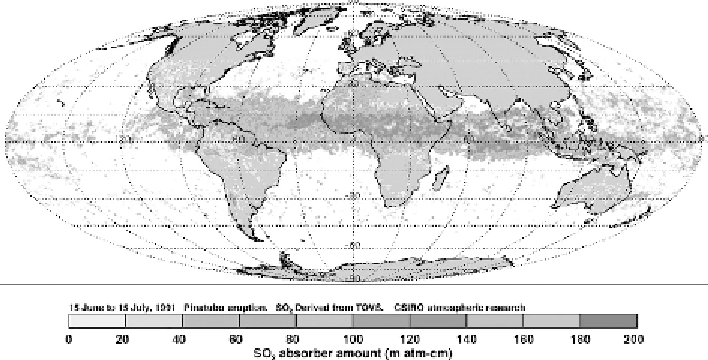Environmental Engineering Reference
In-Depth Information
volcanic activity was pioneered in Japan by Y. Sawada (Sawada,
1983
) at the
Japan Meteorological Agency, and Malingreau and Kaswanda (
1986
) published a
paper showing how weather satellite data (from the AVHRR) could be used to
study Indonesian volcanoes.
These early uses of satellite data to monitor mostly volcanic ash and SO
2
established the basis for future uses and encouraged researchers to develop
innovative methods for exploiting satellite data. At the end of 2013 there is still
no satellite instrument in orbit designed speci
cally to measure volcanic emissions,
although as shown in Section 2, many instruments have signi
cant capability
to do so.
Studying volcanic emissions is important for many reasons; perhaps the most
important being because of their effects on the global atmosphere (see Schmidt and
Robock, this volume), on the environment and on health. The eruptions of Mt
Pinatubo in June 1991, which placed
c
.30GtofSO
2
(Bluth
et al
.,
1992
; Guo
et al
.,
2004
) and
c
. 100 Gt of
c
. 0.5 K drop in global surface temperatures in the 3 years following (Robock,
2000
). Operational IR and ultraviolet (UV) satellite instruments measured the SO
2
from Pinatubo as it spread mostly westwards in the stratospheric winds circling the
tropics in about 3 weeks (see
Figure 7.1
). Satellites are less able to quantify
emissions close to the surface, but while developments in technology and algorith-
mic improvements are addressing this issue, ground-based and airborne instru-
ments are also being developed to monitor SO
2
and ash remotely.
Figure 7.1 The global spread of SO
2
from Pinatubo, Philippines observed by the
HIRS (High-resolution Infra-Red Sounder), part of the TOVS (TIROS Oper-
ational Vertical Sounder) suite of instruments on board the polar orbiting NOAA
operational satellites. A black and white version of this
figure will appear in some

